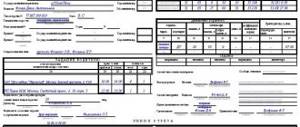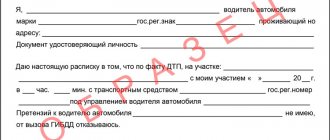A waybill
is the main primary document for recording the driver’s work, mileage, and vehicle route, issued daily to vehicle drivers.
The waybill form refers to the primary documents used in the process of accounting for cargo transportation. The waybill together with the bill of lading form (TTN) are documents characterizing the work of the driver and the vehicle. Both documents serve as the basis for calculating and paying wages to the driver, as well as for calculating the cost of goods transportation services. In 1997, two forms were approved, which are still used for the operation of freight vehicles in Russia.
Why do you need a waybill?
Waybill form 4-c is used for cargo transportation based on piecework wages (the driver completed the trip - handed in the waybill). Waybill form 4-p is used when a temporary tariff is applied. As a rule, this form takes into account the driver’s work during one work shift (one day). At the same time, he can make several flights of the same type for one customer, or two flights for different customers.
The waybill consists of the main part and a tear-off coupon. The tear-off coupon of the form is filled out directly by the customer. The data specified in it serves as the basis for issuing an invoice for work performed by the carrier. The tear-off coupon is an integral part of the invoice and serves as confirmation of the accrued amount for the services of the cargo carrier.
The main part of the waybill form is an accounting document and remains with the carrier. This part of the waybill must contain duplicate data on the time during which the cargo carrier’s vehicle was used and the length of the cargo delivery route. It also reflects data on the forced downtime of the vehicle, the need for additional operation of the vehicle engine and the implementation of work related to the use of equipment installed on the vehicle. It is these data that serve as the basis for calculating the operation of a given vehicle.
If time-based payment is assumed for the road transportation of goods, then the number of each consignment note, which is attached to the waybill, is indicated on the waybill. A copy of the waybill (BW), attached to the waybill form, serves as confirmation of the work performed. Upon completion of the work, records are made and an entry is made in the waybill register, and the total total (in tons) of transported cargo is calculated. Based on the aggregate indicators, the hours of use of the vehicle and the driver’s salary are calculated.
Before the driver starts work, the main part of the waybill form must be filled out by the cargo transportation dispatcher, or the person replacing him. Subsequent entries in the waybill are made by employees of the cargo carrier organization, as well as by the customer (or his representative). The driver does not have to make any entries in the waybill. He signs the waybill only when he accepts the car for work and returns it at the end of the shift. The driver receives waybills from the dispatcher at the beginning of the work shift, and their receipt is certified by a signature. At the end of the work shift, he is required to hand over the waybill. This document is issued only for one work shift or work day. The driver can receive a new waybill only after he hands over the old one to the dispatcher and thus closes the working day.
Filling the tear-off spine
Each waybill has a tear-off spine containing a coupon of the first and second customers, which are transferred to the organization - the shipper.
When filling out, you must follow the following rules:
- At the top of each coupon the details of the waybill, which is the basis for the carriage, are indicated.
- The parameters of the work performed are indicated:
- time spent on order fulfillment
- number of flights
- total vehicle mileage
- tariff according to which wages are calculated, etc.
- After filling out, each coupon is signed by the taxi driver (if available) and the head of the operational department.
What documents are attached to the sheet
The list of documents attached to the waybill varies depending on the type of cargo being transported. The following must be attached:
- waybill
- invoice for services
Additionally you may need:
- documents permitting the transportation of large or dangerous goods
- certificates of conformity
- certificates issued by various organizations confirming various facts
How to correctly make entries in the travel form
The order of filling out the columns of the waybill is strictly regulated. Filling occurs as follows:
- The date (day, month and year) is indicated under the name of the document, which must correspond to the date entered in the registration journal for the issuance of travel documents;
- Next comes a line in which the work code should be indicated. It is this code that serves as the basis for calculations and payment of wages to the driver;
- The columns “Brigade” and “Column” reflect the numbers of the vehicle fleet units to which the truck or the driver himself is assigned;
- The “Vehicle Data” column must contain data on the make of the car, its registration numbers (state and garage);
- Lines containing official and personal information about the driver must be filled in with the following data. This includes the driver’s surname and initials, his license number, his personnel number assigned according to the organization’s staffing table, as well as the driver’s class;
- If transportation of cargo requires a license, then you must fill out the column with information about the license card. This column indicates the series and number of the card, as well as its type. By type, license cards are divided into limited and standard;
- The “Trailers” column must contain the state and garage number of the semitrailer or trailer, as well as the brand, if the use of these means is necessary for the cargo transportation process. If trailers are expected to be replaced during cargo transportation, then their numbers and brands are entered directly on the spot;
- The column “Accompanying persons” must contain information about the persons who accompany the driver when transporting cargo. These persons can be trainees, forwarders, loaders. This column contains the surname and initials of employees, as well as the documents on the basis of which they carry out their work;
- The column “Work of the driver and the vehicle” must contain information about the time of departure of the vehicle from the territory of the motor transport enterprise and the time of its return to the territory of the vehicle fleet;
- In the column “Assignment to the driver”, the freight dispatcher or other person enters the address of the customer’s location, at whose disposal the driver with the vehicle is placed;
- The column “At whose disposal” requires the customer to indicate the person with whom the driver will specifically contact while performing the work. Often this is the customer himself, but this person can be a trusted representative of the client. The authorized person carries out his duties on the basis of a power of attorney. It is best to attach a copy of the power of attorney to documents (waybills and waybills);
- The “Arrival time” line must contain data, indicated in hours and minutes, about the time of arrival of the vehicle at the customer’s location to perform one-time work. If the services under the contract involve the completion of work over several days, then the time is recorded in this column according to the schedule specified in the contract;
- The address columns for the loading and unloading point (No. 20-21) must reflect the actual addresses of the point of loading of goods and the point of delivery (unloading) of goods;
- The line “Name of cargo” contains the full name of the goods intended for transportation;
- The line "Number of trips with cargo" should reflect the required number of trips required to complete a particular task. The task is determined in the application or in a single order;
- The “Distance” column contains data on the length of the route. Kilometers can be determined from data from road organizations or a map of the city (region). You can also use data from previous cargo transportation. Kilometers can be calculated on any transport exchange operating on the Internet, for example ATI.SU. As a rule, the data provided by transport exchanges is quite accurate, and the mileage calculation service is absolutely free;
- The column “Transport tons” contains data on the amount of cargo in tons that needs to be transported.
Any changes to the waybill regarding the driver’s assignment may be made only by an employee of the motor transport organization that owns the vehicle. In case of agreement between the parties (carrier and client), this can be done by a person authorized by the customer or by the customer himself.
On the front side of the waybill form there is a column “Issue fuel”, which indicates the amount of fuel required for the operation of the vehicle. The amount of fuel required is entered in the column in words, taking into account unused fuel over the past day. The completely filled out sheet by the dispatcher is certified by his signature. Thus, the dispatcher certifies the correctness of completion and reliability of all entered data, including the fact that the driver has a driver’s license.
Their shelf life
All sheets must be stored for five years. This is the minimum period, according to Order No. 152 of the Ministry of Transport. Either company managers or officials must retain papers.
Several categories of government organizations can check such DPs:
- traffic police;
- Federal Tax Service of Russia;
- GIT.
If the document is not found in the enterprise, based on the results of the inspection, a fine is imposed - in accordance with Article 12.31.1 of the Administrative Code:
- in the amount of 500 rubles for the driver himself;
- 20 thousand rubles to an official at the enterprise;
- 100 thousand rubles in relation to a legal entity or individual entrepreneur.
Drawing up a waybill involves using an up-to-date form. The state allows it to be developed independently.
Each enterprise and type of vehicle has its own form of reporting document. But storage of any of them is mandatory and the period is set at five years.
How to fill out a waybill before leaving the garage
There are not many columns to be filled out in this part of the sheet. Following the recommendations, filling out this form is often quite simple.
- The columns related to the section “Fuel Movement” are filled out by the tanker or fuel and lubricants technician. These columns record data on the fuel actually received to carry out the work;
- The front side of the travel document form must contain a note about the medical examination. A medical examination is a mandatory procedure before the start of cargo transportation work. Only an officially authorized person with a medical education performs a medical examination and fills out the necessary columns of the waybill. The purpose of the medical examination is to determine the driver’s health status and his ability to drive a vehicle;
- Before the vehicle leaves for the line, a specialist from the technical control department or checkpoint must record data from the car’s speedometer and enter this information in the “Speedometer readings” column. The column is located in the “Car and Driver Operation” section;
- These same specialists reflect the time the car left the line. The time is recorded in the “Actual time” column. It is possible to enter data either manually or using a stamp. Sequence of data indication: date, month, hours and minutes;
- Another column related to the “Fuel Movement” section reflects the remaining fuel in the vehicle’s tanks when leaving the route. This data is recorded by the fuel and lubricants mechanic in column No. 12 of the waybill;
- The waybill form contains lines that reflect the actual condition of the vehicle (its suitability for work, technical notes and recommendations). This section is filled out by a quality control mechanic and indicates the vehicle’s readiness for work, and also serves as permission for the driver to leave. This section is certified by both the mechanic and the driver’s personal signature.
Mandatory document details
Russian legislation does not limit the management of organizations and allows them to draw up their own documents. This makes use easier and more convenient.
At the same time, it is necessary to enter a number of details that must be present in the PL. All these positions are specified in separate orders of the Ministry of Transport - under numbers 17 and 476.
The total number of points to be entered in the form is 14:
- name - Waybill;
- document number - according to the organization’s journal;
- for what periods was it issued;
- who is the owner of the vehicle;
- type and model of vehicle carrier;
- state registration plate number;
- odometer readings - release to the line and return to the garage;
- date and time of leaving and entering the garage;
- signature and full name of the employee drawing up the form;
- Full name of the car driver;
- the date and exact time of the medical plan examination of the person who will drive the vehicle;
- Full name of the person responsible for the medical examination - his signature and seal are also required;
- data on the inspection of the technical condition of the vehicle - the date and time are posted;
- Full name and signature of the person who checks the technical condition of the car.
How to fill out a waybill on the route
Consider the procedure for filling out the travel form using the example of form No. 4-c.
- Column No. 27 contains information about the numbers of all flights made. This is necessary for subsequent sorting of all attached delivery notes;
- The next column must contain the numbers of all waybills attached to the waybill;
- Data on the date and time of provision of the waybill form to the consignee or sender are entered in columns No. 28-30. This occurs if a checkpoint is provided on the territory of the customer or consignee. Otherwise, these columns are not filled in, and the data is entered in the corresponding lines of the consignment note;
- Columns No. 39-40 contain the full name of the shipping organization. Data about the shipper (name and details) are certified by the signature of the shipper or an authorized representative, and also certified by a seal;
- If any unforeseen circumstances arise that cause downtime, in this case the line “Downtime on the line” is filled in. The data is entered by the appropriate specialist (technical assistance employee) or any other authorized person. The column must indicate the reasons for the downtime, the date and the exact time period during which the vehicle was idle. Data on downtime is certified by the signatures of the persons who filled out this column;
- On the front side of the waybill there is a section “Special notes”. It contains data that is not included in the waybill: comments and refusals of the customer to carry out work or vehicles, comments from traffic police officers and road service specialists.
Procedure for filling out the front side
The volume, type and code of fuel at the beginning and end of the shift are indicated here. Here you should also write information about the special equipment used and coefficients that reflect the operating conditions of the truck. The data is signed by the responsible persons.
The procedure for entering a task into the 4-C waybill
In the next column, the dispatcher describes in detail the task for the driver, including the time and address of delivery, as well as the type of cargo being delivered, the name of the company that owns the truck, tonnage, mileage and the total number of trips. Based on this information, the required amount of fuel is calculated. The results are recorded in the appropriate column. The responsible person endorses this with his signature.
Similar information is indicated for the trailer of a truck. On the front side of the document you should write the state number of the truck, its type and brand, code with the operating mode of the brigade and column, and garage identifier. On the eve of the trip, the driver is examined by a doctor, who decides to allow him on the route by placing a stamp on the waybill (the stamp has been canceled since 2021). The mechanic inspects the car upon departure and return to determine its technical condition. He hands over the truck to the driver (upon arrival in the reverse order, the driver hands over the car to the mechanic), validating his actions with endorsement signatures. Information about the training of the traffic police inspector, the traffic accident or repair is indicated in the “Special notes” column.
Rules for filling out a waybill when returning to the car park
After the vehicle returns to the garage, filling out the waybill form continues. The following data is entered into it:
- The first step is to fill out the “Works of the vehicle and trailers” section. This includes data on the flights made, the amount of fuel consumed, the time spent performing work, as well as the actual mileage during the shift;
- The “Fuel Movement” section contains lines about the remaining fuel, which are filled in by the quality control mechanic. The fuel and lubricants technician confirms the actual delivery of remaining fuel by the driver;
- After handing over the vehicle (the condition is recorded by the quality control department mechanic and is determined as satisfactory or unsatisfactory), the driver puts a mark in the “Passed” column, which is certified by the signature of the quality control department mechanic.
Working with the waybill after the driver has handed it over to the freight dispatcher
After the vehicle has been returned to the fleet and the waybill has been filled out by all services, the driver hands it over to the dispatcher, who continues filling it out.
- The section “Operation of the driver and the vehicle” is completed first. The following data is entered in the “Zero mileage” column: mileage from the gate of the motor transport enterprise to the loading point, and from the unloading point to the garage;
- The section “Fuel Movement” is quite extensive; several lines need to be filled in here. “Normal change coefficient” contains information about the general standard for changes in fuel consumption. This coefficient is associated with changes in fuel consumption rates. Lines about the operating time of special equipment and engine operation are filled in based on documented data. This includes data on the use of special equipment and its operating time, as well as data on additional engine operation (during loading and unloading operations, for example). This information must be entered into the waybill to determine the fuel consumption rate. After filling out the appropriate fields, the dispatcher certifies them with his signature;
- The section “Sequence of task completion” is the final stage. The dispatcher enters the total number of completed flights. The entry is made in the final line of column No. 27. The line “Transportation documents in quantity” reflects the total number of delivery notes handed over by the driver. Confirming the number of documents accepted and handed over to the dispatcher, the driver puts his signature in the “Submitted by the driver” column, and the dispatcher also signs in the “Accepted” column.
Filling rules
From March 1, 2021, vouchers must be issued before the start of the flight, if its duration exceeds the driver’s work shift, or before the start of the first flight, if the driver manages to make several flights during one shift. If several vouchers are issued for one vehicle (if it is used by several drivers), the date, time and odometer readings are entered into the documents as follows:
- in the ticket of the driver who leaves first - data when the vehicle leaves the parking lot;
- in the driver's ticket who is the last to arrive - data when the vehicle enters the parking lot.
Otherwise, filling out a truck waybill is not particularly difficult. In it you need to write down data about the date of departure of the car and be sure to write down the type of task, it could be:
- business trip;
- work according to schedule;
- working on weekends or holidays;
- Column;
- brigade;
- and so on.
A prerequisite is accurate information about the vehicle and its driver: you must enter the registration number, make and garage number of the vehicle, data on the trailer, if used, as well as full name. driver and information about his license. The sample will show all the nuances of filling out: how to correctly fill out a truck waybill 2021 (you can download the completed sample and use the form, changing the details).
Data about the vehicle and driver are filled in as follows:
The column “Tasks for the driver” should also not cause difficulties. It should include the addresses and names of all customers, as well as indicate the distance to each destination and note the number of flights. The time of arrival and departure of the vehicle is also indicated.
The section on the movement of fuel contains fields for filling in the brand of fuel, the code of this brand, the operating time of the vehicle engine and the special equipment that is installed on it. It is imperative to know and enter the coefficient of change in fuel consumption rate if the vehicle is operated in special conditions, for example, in cold weather. All completed fields are certified by the signatures of responsible persons.
Waybills are stored in the accounting department of the owner or lessee of the transport. Based on the waybill, records of the vehicle’s operation are kept, so it is advisable to store them together with shipping documents that make it possible to check them simultaneously. A mechanic or dispatcher accepts permits from drivers. If any breakdowns occur, then in the “Marks” column such an authorized person enters information about the repairs performed, its cost, as well as the spare parts that were used. Based on these data, the accounting department, where the voucher must be submitted, must calculate the salary, as well as the costs of operating the vehicle.
How to correctly fill out the travel document form No. 4-p
The form of the waybill of this form is slightly different from the previous form No. 4-s. The section “Assignment to the driver” differs in its filling features. This section must be filled out by the dispatcher according to the data submitted in the application or one-time order of the client.
- Column No. 18, reflecting at whose disposal the driver with the vehicle comes, must include information about the client (name of his organization and location of the work site);
- Lines No. 19-20 reflect the time of arrival of the vehicle to perform work, as well as the time of departure;
- Column No. 21 contains data (in hours) on the approximate time allotted to complete the necessary work;
- Line No. 22 contains data on the required number of flights.
The tear-off coupon of the waybill form is filled out only by the customer. After this, it is handed over to the driver, who submits it along with the waybill to the accounting department. Based on the tear-off coupon, the customer is issued an invoice for the work actually performed, which he must pay. Filling out the tear-off coupon must also occur in accordance with the rules.
The driver presents the customer with a waybill. The customer, based on the data of this waybill, enters the number of the waybill and the date of its issue in certain sections of the tear-off coupon. Also included here are the details of the cargo carrier company, the brand and state registration number of the vehicle that arrived to perform the work.
The “Customer” line must contain the full name of the customer organization and the details of the official authorized to manage the arriving vehicle. Also in the tear-off coupon, the time of arrival of the vehicle and the time of its departure are entered in the corresponding columns. The customer fills out the column “Attached shipping documents”, which indicates the actual quantity and numbers of documents. One copy of each TTN must be attached to the travel document form.
The tear-off coupon contains information about the trips actually made by the driver; the corresponding column is filled in by the customer. Upon completion of filling out all the necessary information, the customer (or his authorized representative) certifies all entered data with his signature and the seal of the company.
Formal and actual responsibility for errors made when filling out the waybill form falls on the head of the enterprise (both the cargo carrier and the customer) or persons authorized to carry out this work. This includes both technical personnel responsible for the operation of vehicles (QD mechanics or gas station attendants) and persons whose responsibilities include filling out waybills (freight dispatchers).
Sample form and filling example
For freight vehicles, two forms of waybills are used: 4-C (for piecework payment for the driver’s work) and 4-P (for using time-based pricing for the driver’s work), approved by the appendix to Goskomstat Resolution No. 78. Organizations also have the right to independently develop the form of the document, taking into account all the requirements established by Order of the Ministry of Transport No. 152.
Additionally, a separate form has been approved for international transportation (Form 4-M). On this website you can view the document forms and download them here for filling out yourself.
On the territory of the Russian Federation
To carry out activities on the territory of the Russian Federation, forms 4-C and 4-P are filled out according to the following scheme:
- Name and number of the document. If a printed form is used, the document series may additionally be indicated.
- Validity period of the voucher (from what date and until what date).
- The organization is the owner of the vehicle. If the truck belongs to a legal entity, then you must indicate:
- name and form of ownership of the company
- business registration address
- OGRN (number assigned upon registration of a legal entity)
- contact number
- OKPO code in accordance with the all-Russian classifier
- Truck details:
- make and model
- state registration plate issued by the traffic police after registration of vehicles
- parking number (if the enterprise has this classification)
- operating mode, column and brigade numbers (if necessary)
- Driver's full name (full details)
- driver's personnel number (if available)
- details (series and number) of the driver's license, as well as open categories of transport
- similar trailer data (if available)
- list of accompanying persons (loaders, forwarders, etc.)
- Start and end data of the flight:
- departure date and time
- zero mileage (distance from the base to the place of first loading and from the place of last unloading to the parking lot)
- odometer reading
- signature and transcript of the signature of the responsible person (mechanic, dispatcher, etc.)
- Fuel movement, which determines fuel consumption:
- balance at the beginning of the work shift
- added
- balance at the end of the flight (end of shift)
- correction factor established for a given type of transport
- operating time of the engine and special equipment installed on the vehicle
- signatures of the mechanic (dispatcher) and refueler
- The task given to the driver. It is recommended to indicate at what time the driver must arrive at the disposal of the transportation customer, how long it will take for loading, how long it will take for transportation to the destination, the time allotted for unloading, and so on.
- Data on pre-trip inspection, driver's license check and vehicle serviceability.
Also read: how to draw up a power of attorney in Business Lines to receive cargo for an individual entrepreneur, individual or company.
Next, the process of filling out the voucher depends on the form of the document:
| In form 4-C | The sequence of performing the assigned tasks and the results of the vehicle operation are indicated. |
| In 4-P form | List of work performed and the result of each action |
An example of a completed waybill is shown in the figure:
International
The main difference between an international waybill and a domestic Russian document is the possibility of setting longer validity periods than one flight or one shift. Next, all columns are filled in in the same way.









